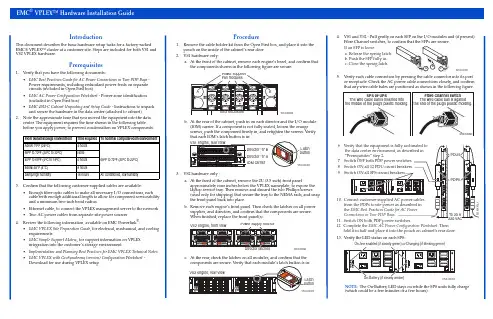EMCVPLEX安装实施方案
EMCVPLEX数据中心虚拟化方案

02
方案设计
根据需求分析结果,设计符合客户需 求的虚拟化方案,包括资源分配、网 络设计、安全策略等。
01
03
安装部署
根据设计方案进行虚拟化软件的安装 和硬件资源的配置。
上线运行
将虚拟化系统正式投入使用,并进行 长期的监控和维护。
05
04
系统调试
对安装好的虚拟化系统进行调试,确 保系统的稳定性和性能。
实施效果
通过虚拟化方案的实施,该企业的数据中心性能得到了显著提升,同时降低了运营成本, 提高了服务质量和可靠性。容灾备份方案的实施也确保了数据的安全性和业务的连续性。
06
EMC Vplex未来展望与 总结
Vplex未来发展趋势
扩展性
Vplex继续提供更高的可扩展性,以满足不 断增长的数据需求。
安全
04
EMC Vplex解决方案详 解
Vplex数据中心架构
架构概述:Vplex数据中心架构是一种高 度可扩展的虚拟化平台,旨在提高数据 中心的效率、灵活性和可用性。
多租户支持:Vplex支持多租户隔离,为 不同业务部门提供独立的资源池。
分布式架构:Vplex采用分布式架构,可 扩展至数千个节点,满足大型企业的需 求。
02
数据中心虚拟化概述
什么是数据中心虚拟化?
数据中心虚拟化是一种将物理服务器和基础设施资源抽象成逻辑资源的技术,它 允许在一个物理服务器上运行多个虚拟机,每个虚拟机都有自己的操作系统和应 用程序。
数据中心虚拟化通过软件定义的网络和存储技术,将网络和存储资源划分为可动 态分配的虚拟机,从而提高了服务器的利用率,简化了管理流程,并降低了运营 成本。
纵向扩展:Vplex支持 纵向扩展,通过升级硬 件设备提高单节点的性 能和容量。
emcvplex安装实施方案

VPLEX-LOCAL的硬件配置信息此次安装的VPLEX-Local有单台台VPLEX组成,VPLEX的硬件配置如下:1)1个Engine2)2个Director,每个Engine由两个Director组成3)8个8Gb前端FC端口,每个Director包含一块前端FC卡,共4个8Gb的前端FC端口,由于交换机端口限制,本次使用4个前端FC端口(每个Directo上两个)。
4)8个8Gb后端FC端口,每个Director包含一块后端FC卡,共4个8Gb的后端FC端口。
本次使用4个前端FC端口(每个Directo上两个)5)4个可用的8Gb的VPLEX-Local级联FC端口,每个Director包含一块VPLEX-Local级联FC卡,共4个8Gb的级联FC端口,但是只有两个可用VPLEX-LOCAL的硬件介绍单台VPLEX的硬件布局VPLEX的ENGINE的硬件布局VPLEX-LOCAL的级联端口连接PLEX-LOCAL 拓扑结构VPLEX-LOCAL 的FABRIC 拓扑图Fabric Switch Engine power supplyManagement serverFabric SwitchVNX VNXVPLEX Host HostVPLEX-LOCAL 后端存储系统的配置VMAX_3358Vplex Meta volume ( >= 78GB, using 144GB )Vplex Meta volume backup ( >=78GB, using 144GB )VPLEX logging volume ( >=10GB, using 72GB )Host data volume VMAX_0251HOST_BAKHOST_PRD VPLEX_0550VPLEX_0549Host data volume Host data volumeMETA VOLUME 的配置请注意每台VNX 必须使用两个RG ,每个RG 各提供两个80G LUN 。
EMCVPLEX安装实施计划方案

VPLEX-LOCAL 的硬件配置信息此次安装的VPLEX-Local有单台台VPLEX组成,VPLEX的硬件配置如下:1) 1 个Engine2) 2 个Director,每个Engine 由两个Director 组成3)8个8Gb前端FC端口,每个Director包含一块前端FC卡,共4个8Gb的前端FC端口,由于交换机端口限制,本次使用4个前端FC端口(每个Directo上两个)。
4)8个8Gb后端FC端口,每个Director包含一块后端FC卡,共4个8Gb的后端FC端口。
本次使用4个前端FC端口(每个Directo上两个)5)4个可用的8Gb的VPLEX-Local级联FC端口,每个Director包含一块VPLEX-Local级联FC卡, 共4个8Gb的级联FC端口,但是只有两个可用VPLEX-LOCAL的硬件介绍单台VPLEX的硬件布局VPLEX的ENGINE的硬件布局Note:SPS = Standby Power SupplyVPLEX-LOCAL 的级联端口连接Cluster 1(sama connections from each engine in clusterCluster 2^same connections from each engine in duster)int&ncluste r i 一 COM SAN —switch 1BinlorcluslorCOM SAN >switch 20 —VPLEX-LOCAL 拓 扑结构=1B2TC00 A2-FOOOB2-FC01A2-FO01int&rciuster ISL 1 inierciusierCOM SAN COM SAN switch 1A switch 2AB2 FC00 A2 FCOONOTE: ISLTisIntar-switcli linkB2-FOO1 A2-FC01IOM BO IOM 81IOM B2 / IOM B3一口口口 DO 口口口吕吕 。
EMC VPLEX-Hardware-Installation-Guide

IntroductionThis document describes the basic hardware setup tasks for a factory-racked EMC® VPLEX™ cluster at a customer site. Steps are included for both VS1 and VS2 VPLEX hardware.Prerequisites1.Verify that you have the following documents:•EMC Best Practices Guide for AC Power Connections in Two-PDP Bays - Power requirements, including redundant power feeds on separate circuits (included in Open First box)•EMC AC Power Configuration Worksheet - Power zone identification (included in Open First box)•EMC 40U-C Cabinet Unpacking and Setup Guide - Instructions to unpack and secure the hardware in the data center (attached to cabinet)2.Note the approximate time that you moved the equipment into the data center. The equipment requires the time shown in the following table before you apply power, to prevent condensation on VPLEX components.3.Confirm that the following customer-supplied cables are available:•Enough fiber-optic cables to make all necessary I/O connections, each cable with enough additional length to allow for component serviceability and a minimum two-inch bend radius •Ethernet cable, to connect the VPLEX management server to the network •Two AC power cables from separate site power sources4.Review the following information, available on EMC Powerlink ®:•EMC VPLEX Site Preparation Guide , for electrical, mechanical, and cooling requirements •EMC Simple Support Matrix , for support information on VPLEX integration into the customer’s storage environment •Implementation and Planning Best Practices for EMC VPLEX Technical Notes •EMC VPLEX with GeoSynchrony (version) Configuration Worksheet - Download for use during VPLEX setupProcedure1.Remove the cable holder kit from the Open First box, and place it into the pouch on the inside of the cabinet’s rear door.2.VS1 hardware only:a.At the front of the cabinet, remove each engine’s bezel, and confirm that the components shown in the following figure are secure:b.At the rear of the cabinet, push in on each director and the I/O module (IOM) carrier. If a component is not fully seated, loosen the orange screws, push the component firmly in, and retighten the screws. Verify that each IOM’s latch button is in:3.VS2 hardware only :a.At the front of the cabinet, remove the 2U (3.5 inch) front panelapproximately nine inches below the VPLEX nameplate, to expose the laptop service tray. Then remove and discard the two Phillips screws (used only for shipping) that secure the tray to the NEMA rails, and snap the front panel back into place.b.Remove each engine’s front panel. Then check the latches on all power supplies, and directors, and confirm that the components are secure. When finished, replace the front panel(s).c.At the rear, check the latches on all modules, and confirm that the4.VS1 and VS2 - Pull gently on each SFP on the I/O modules and (if present) Fibre Channel switches, to confirm that the SFPs are secure.5.Verify each cable connection by pressing the cable connector into its port or receptacle. Check the AC power cable connections closely, and confirm that any wire cable bales are positioned as shown in the following figure.13.Verify the LED status on each SPS:NOTE: The On-Battery LED stays on while the SPS units fully charge (which could be a few minutes or a few hours).From transit/storage environment Time required To nominal computer room environment Above 75o F (24o C) 4 hours 68o F to 72o F (20o C to 22o C)68o F to 72o F (20o C to 22o C)None 40o F to 65o F (4o C to 18o C) 4 hours Below 40o F (4o C)8 hours Damp/high humidity16 hoursAir conditioned, low humidity14.Connect customer-supplied fiber-optic cables from the front-end andback-end SANs to the appropriate VPLEX I/O ports. Do not touch the ends of any fiber-optic cable, to avoid damage or contamination.Use redundant physical Fibre Channel links to connect each host to theVPLEX directors, as well as each VPLEX director to the back-end storage. To prevent data unavailability, ensure that each host in a storage view has paths to at least two directors in a cluster, and that multipathing is configured to distribute the paths evenly between directors A and B in each engine:15.Route the cables to the sides of the cabinet as shown in the followingfigure, to prevent blocking components. Maintain a minimum radius oftwo inches for any bend in a Fibre Channel cable. (In a VS2 cabinet, route the cables along the cable management trays.)Route the cables up or down the sides of the cabinet through the plastic cable holders, and out the top or bottom of the cabinet.16.Connect the management server to the customer IP network:17.VPLEX Metro™ or VPLEX Geo™ only - Connect the intercluster cables asshown in the figure that applies to your WAN COM connection. Ensurethat each director has two independendent paths to each director in theother cluster. (The connections are the same for each engine in a cluster.)•VS1 directors with WAN connections over Fibre Channel:•VS1 directors with WAN connections over IP:•VS2 directors with WAN connections over Fibre Channel:•VS2 directors with WAN connections over IP:Next steps1.Download and install the VPLEX Procedure Generator from Powerlink toaccess additional service, maintenance, and troubleshooting information.2.Work with the customer to complete the EMC VPLEX with GeoSynchrony(version) Configuration Worksheet, and give it to the customer.3.Follow the procedures in the EMC VPLEX with GeoSynchrony (version)Configuration Guide to configure the cluster for operation in the customerenvironment.Copyright © 2011 EMC Corporation. All rights reserved.Published June 2011EMC believes the information in this publication is accurate as of its publication date. However, the information issubject to change without notice.THE INFORMATION IN THIS PUBLICATION IS PROVIDED “AS IS.” EMC CORPORATION MAKES NOREPRESENTATIONS OR WARRANTIES OF ANY KIND WITH RESPECT TO THE INFORMATION IN THISPUBLICATION, AND SPECIFICALLY DISCLAIMS IMPLIED WARRANTIES OF MERCHANTABILITY ORFITNESS FOR A PARTICULAR PURPOSE.Use, copying, and distribution of any EMC software described in this publication require an applicable softwarelicense.For the most up-to-date regulatory document for your product line, go to the Technical Documentation andAdvisories section on EMC Powerlink.For the most up-to-date listing of EMC product names, see EMC Corporation Trademarks on .All other trademarks used herein are the property of their respective owners.P/N 300-012-308 Rev A01。
VTM系统生产存储vplex实施方案

VTM生产系统存储更换实施方案目录实施过程概述本次实施为泰安银行VTM系统原有数据迁移至EMCVPLEX平台,实现在EMCVPLEX平台的数据双活。
项目涉及的设备有原有存储IBMV7000、EMCVPLEX 和IBMF96。
目的是为了数据实现存储IBMV7000与EMCVNX5600存储双活。
1VTM系统设备接入生产环境1.1VTM系统连接示意图1.2SAN交换机端口分配示意图1.3SAN交换机ZONE配置1.3.1通讯要求VTMDF2_S2_P0Sw2:12Vplexvplex-E1DA-FE1 Sw2:52vplex-E1DB-FE1 Sw2:53 vplex-E2DA-FE1 Sw2:54 vplex-E2DB-FE1 Sw2:55VTMv7000V7000_A_1SW1:0Vplexvplex-E1DA-FE0 Sw1:48 VTMv7000存储连接vplex 后端vplex-E1DB-FE0 Sw1:49 V7000_B_1SW2:4vplex-E2DA-FE0 Sw1:50vplex-E2DB-FE0 Sw1:51 V7000_A_3SW1:0Vplexvplex-E1DA-FE1 Sw1:48vplex-E1DB-FE1 Sw1:49 V7000_B_4 SW2:4vplex-E2DA-FE1 Sw1:50 vplex-E2DB-FE1 Sw1:511.3.2 Zone 配置交换机SW1上的ZONE 配置主机zone 名称主机端口 存储端口 VTMappyxv7000_vtmdbfs1_slot18口 0、4口 vtmdbfs1_slot1_vplex_fe 8口 52、53、54、55口VTMDByxv7000_vtmdbfs2_slot112口 0、4口 vtmdbfs2_slot1_vplex_fe 12口52、53、54、55口VTMv7000 V7000_A_1_VPLEX_BE 0、4口48、49、50、51口V7000_B_1_VPLEX_BE交换机SW2上的ZONE 配置主机zone 名称主机端口存储端口VTMapp yxv7000_vtmdbfs1_slot2 8口0、4口vtmdbfs1_slot2_vplex_fe 8口52、53、54、55口VTMDB yxv7000_vtmdbfs2_slot2 12口0、4口vtmdbfs2_slot2_vplex_fe 12口52、53、54、55口VTMv7000 V7000_A_3_VPLEX_BE0、4口48、49、50、51口V7000_B_3_VPLEX_BE2实施前的准备工作注:请联系相关业务管理人员完成下面的工作2.1通知受影响的各业务部门2.2数据备份注:请联系相关业务管理人员做好数据备份工作3查询主机相关信息3.1获取主机的HBA卡信息3.1.1VTMAPP主机信息FC名称WWN号位置描述备注vtmdbfs1_slot1 10:00:00:90:fa:bb:e4:b2 slot1vtmdbfs1_slot2 10:00:00:90:fa:bd:a1:c8 slot23.1.2VTMDB主机上的HBA卡信息FC名称WWN号位置描述备注vtmdbfs2_slot1 10:00:00:90:fa:bd:a1:ca slot1vtmdbfs2_slot2 10:00:00:90:fa:bc:b5:2a slot23.2获取主机VG信息3.2.1VTMAPP(152)主机VG信息VTMAPP主机上所有VGvg_fssize=200Gasm-disk2dg_datasize=2.0Gasm-disk0dg_ocrsize=120Gasm-disk1dg_orasize=200Gasm-disk4dg_backup--没有在oracle中使用size=2.5Tfssize=200Gasm-disk3dg_index3.2.2VTMDB(153)主机上的VG信息VTMDB主机上所有VGvg_fssize=200Gasm-disk2dg_datasize=2.0Gasm-disk0dg_ocrsize=120Gasm-disk1dg_orasize=200Gasm-disk4dg_backup--没有在oracle中使用size=2.5Tfssize=200Gasm-disk3dg_index3.3获取主机的PV信息3.3.1VTMAPP(152)主机上所有的PV信息Pv-name Pv_大小PVUUID Vg_name/dev/dm-8 2.5TB 2Cerob-o20h-cXTN-K86T-aR23-jTzh-CpxxsXvg_fs3.3.2VTMAPP(152)主机上所有的LV信息3.3.3VTMDB(153)主机上的所有PV信息3.3.4VTMDB(153)主机上所有的LV信息4EMC存储分配LUN4.1EMC存储划分LUN4.2V7000存储主机映射排序4.2.1EMCVPLEX添加主机1、在v7000上注册VPLEX的后端端口。
VTM系统生产存储vplex实施方案

VTM生产系统存储更换实行方案目录实行过程概述............................................................................................... 错误!未定义书签。
1VTM系统设备接入生产环境............................................................................. 错误!未定义书签。
1.1VTM系统连接示意图........................................................................... 错误!未定义书签。
1.2SAN互换机端口分派示意图................................................................ 错误!未定义书签。
1.3SAN互换机ZONE配置......................................................................... 错误!未定义书签。
通讯规定......................................................................................... 错误!未定义书签。
Zone配置 ....................................................................................... 错误!未定义书签。
2实行前旳准备工作....................................................................................... 错误!未定义书签。
EMC vplex Isilon DD存储备份双活系统实施方案
2016年3月目录1.项目实施内容 (5)1.1存储系统架构示意图 (6)1.3本项目设备硬件配置 (6)2.存储系统实施基础配置 (7)2.1双活数据中心存储实现模式 (7)2.2光纤通道交换机端口连接表 (8)2.3VPLEX端口作用描述 (9)2.4VPLEX端口的使用 (9)2.5存储设备线路连接描述 (9)2.6存储设备端口命名规则 (10)3.SAN存储规划 (10)3.1存储设备连接线缆数量及种类 (10)3.2存储设备IP地址配置 (11)3.3VPLEX的端口连接配置 (11)4.VPLEX METRO实施步骤 (12)4.1VPLEX前期准备 (12)4.1.1 system volumes (12)4.2S WITCH ZONING (13)4.3B ACKEND STORAGE PROVISIONQ (13)4.4VPLEX INITIAL SETUP (13)4.4.1 Configip address and hostname of VPLEX (13)4.4.1.1 Connect to management server (13)4.4.1.2 entering the VPLEXCLI (14)4.4.1.3 set the management server ipaddress (14)4.4.1.4 change the hostname of VPLEX (14)4.4.1.5 check software version (14)4.4.2 use EZ-setup to initialize the VPLEX1 (15)4.4.2.1 Start EZ-setup (15)4.4.2.2 Configure the first cluster (15)4.4.2.3 Chose the local authentication (15)4.4.2.4 Configure event notification (15)4.4.2.5 Configure send system report to EMC (16)4.4.2.6 Configure performance statistics collector (16)4.4.2.7 Generate the certificate (16)4.4.2.8 Backend storage discovery (17)4.4.2.9 create meta-data volume (17)4.4.2.10 verify if meta-data volume is successfully created (18)4.4.2.11 create meta-data volume backups (18)4.4.2.12 enable FE port (18)4.4.3 use EZ-setup to initialize the VPLEX2 (18)4.4.3.1 Connect to VPLEX2 (18)4.4.3.2 Sychronize the time on the clusters (18)4.4.3.3 Start EZ-setup on cluster2 (19)4.4.3.4 Configure the Meta-data volume and backup of VPLEX2 (19)4.4.3.5 Complete configuration of cluster1 (19)4.4.3.6 Complete configuration of cluster2 (19)4.4.4 Join the clusters (19)4.4.5 Create logging volumes (20)4.5C HECK THE CLUSTER HEALTH (21)4.6VPLEX BACKEND STORAGE CONNECTIVITY VERIFY (21)4.7C LAIM THE DA TA VOLUME (21)5.ISILON的实施步骤 (23)5.1集群初始化 (23)5.2节点加入 (37)5.3系统健康检查 (38)5.4O NE FS升级 (38)5.5安装补丁包 (38)5.6系统微码升级 (38)5.7硬盘微码升级 (38)5.8管理界面登录 (39)5.9保护级别设置 (39)5.10网络设置 (40)5.10.1 内网设置 (41)5.10.2 外网设置 (41)5.11目录认证服务 (41)5.12SMB共享规划 (41)5.13NFS共享规划 (43)6DATADOMAIN配置步骤 (45)6.1D A TA D OMAIN配置之前实施内容 (45)6.2D A TA D OMAIN VTL配置 (46)7存储设备的使用示范 (55)7.1操作流程 (55)7.2操作示例 (56)7.2.1 光纤交换机操作部分 (56)7.2.2 EMC VNX7600操作部分 (59)7.2.3 VPLEX 操作部分 (62)1.项目实施内容XX公司双活数据中心灾备项目采用EMC VPLEX METRO解决方案,实现院区主机房和灾备机房容灾。
EMC_VPlex存储双活建设方案详细
2012年11月
一、
目前XXX市社保已经在使用EMC的存储系统VNX5100,为了进一步保障社保应用的高可用性,提高生产的安全级别,XXX市社保计划对目前的存储系统进行虚拟化整合,并搭建双活存储系统,保证关键业务所使用的存储系统即使有一台存储系统出现故障,也不会出现业务停顿,达到更高的生产安全保障。
VNX 7500还支持LUN的条带化或级联式扩展,以将数据分散到更多的磁盘上;
C.中心机房-存储虚拟化:以EMC VPlex Local作为存储虚拟化;应用系统只需要访问虚拟化存储,而不需要直接管理后端的具体的存储系统;通过存储虚拟化,可以达到两台存储之间双活,可以支持异构的存储系统,对数据进行跨存储的本地及远程保护,统一管理接口和访问接口;
当应用系统读数据时,VPlex采用了AccessAnywhere技术,应用系统只需要就近访问最近的一台存储系统即可,可以大大节省两个数据中心之间的网络传输带宽;
当存储系统故障时,VPlex采用的Active-Active技术,结合服务器的集群文件系统(Cluster File System ),可以保证应用实时切换到容灾中心,而不需要人工操作,保证了业务系统的高可用性,大大缩减了故障切换时间。
当VPlex系统自身出现故障时,由于在Vplex中的设置,VPlex不会修改存储系统LUN的配置信息,即,用户可以将存储系统A或B的LUN直接挂到应用系统,保证应用系统的继续运行,不会产生数据丢失。
2.
VPlex在提供虚拟化的存储访问的同时,还可以方便地对存储容量进行扩展。当一台存储系统出现空间不足的情况时,可以通过VPlex的虚拟卷,将多台存储系统的空间组成一个卷给应用使用。通过这种级联方式,应用系统直接访问VPlex的虚拟卷,而VPlex后端接入的存储系统只是作为VPlex虚拟卷的存储资源池使用,达到资源的更合理分配和优化。
EMCVPLEX安装实施实施方案
EMCVPLEX安装实施实施方案————————————————————————————————作者:————————————————————————————————日期:VPLEX-LOCAL的硬件配置信息此次安装的VPLEX-Local有单台台VPLEX组成,VPLEX的硬件配置如下:1)1个Engine2)2个Director,每个Engine由两个Director组成3)8个8Gb前端FC端口,每个Director包含一块前端FC卡,共4个8Gb的前端FC端口,由于交换机端口限制,本次使用4个前端FC端口(每个Directo上两个)。
4)8个8Gb后端FC端口,每个Director包含一块后端FC卡,共4个8Gb的后端FC端口。
本次使用4个前端FC端口(每个Directo上两个)5)4个可用的8Gb的VPLEX-Local级联FC端口,每个Director包含一块VPLEX-Local级联FC卡,共4个8Gb的级联FC端口,但是只有两个可用VPLEX-LOCAL的硬件介绍单台VPLEX的硬件布局VPLEX的ENGINE的硬件布局VPLEX-LOCAL的级联端口连接VPLEX-LOCAL拓扑结构VPLEX-LOCAL 的FABRIC 拓扑图Fabric Switch Engine power supplyManagement serverFabric SwitchVNX VNXVPLEX Host HostVPLEX-LOCAL 后端存储系统的配置VMAX_3358Vplex Meta volume ( >= 78GB, using 144GB )Vplex Meta volume backup ( >=78GB, using 144GB )VPLEX logging volume ( >=10GB, using 72GB )Host data volumeVMAX_0251HOST_BAKHOST_PRD VPLEX_0550VPLEX_0549Host data volumeHost data volumeMETA VOLUME的配置请注意每台VNX必须使用两个RG,每个RG各提供两个80G LUN。
vplex实施方案
vplex实施方案Vplex实施方案Vplex是一种基于存储虚拟化技术的解决方案,可以帮助企业实现存储资源的灵活管理和高可用性。
在实施Vplex方案之前,我们需要对环境进行充分的评估和规划,以确保实施过程顺利、稳定。
本文将从Vplex实施的准备工作、实施步骤和注意事项等方面进行介绍。
首先,进行准备工作。
在实施Vplex方案之前,我们需要对现有的存储环境进行详细的调研和评估,包括存储设备的型号、性能、容量、连接方式等信息。
同时,还需要对存储网络、主机配置等进行全面的了解。
在评估的基础上,我们可以制定详细的实施方案,包括资源调配、网络连接、数据迁移等计划。
其次,进行实施步骤。
在实施Vplex方案的过程中,我们需要按照事先制定的计划,依次进行资源调配、网络连接、数据迁移等操作。
首先,我们需要对Vplex设备进行初始化和配置,确保其与现有存储环境兼容。
然后,进行存储资源的调配和网络连接,确保Vplex设备能够正常工作。
最后,进行数据迁移,将现有的存储数据迁移到Vplex设备上,确保数据的完整性和一致性。
在实施Vplex方案的过程中,还需要注意一些事项。
首先,要确保实施过程中的数据迁移和操作不会对业务造成影响,可以选择在业务低峰期进行。
其次,要对Vplex设备进行充分的测试,确保其性能和稳定性。
最后,还需要对实施过程进行详细的记录和总结,为后续的运维工作提供参考。
综上所述,Vplex实施方案是一个复杂的过程,需要充分的准备和规划。
只有在充分了解现有环境的基础上,制定详细的实施计划,并严格执行,才能确保Vplex方案的顺利实施和稳定运行。
希望本文的介绍能够对您有所帮助,谢谢阅读。
- 1、下载文档前请自行甄别文档内容的完整性,平台不提供额外的编辑、内容补充、找答案等附加服务。
- 2、"仅部分预览"的文档,不可在线预览部分如存在完整性等问题,可反馈申请退款(可完整预览的文档不适用该条件!)。
- 3、如文档侵犯您的权益,请联系客服反馈,我们会尽快为您处理(人工客服工作时间:9:00-18:30)。
VPLEX-LOCAL的硬件配置信息此次安装的VPLEX-Local有单台台VPLEX组成,VPLEX的硬件配置如下:1)1个Engine2)2个Director,每个Engine由两个Director组成3)8个8Gb前端FC端口,每个Director包含一块前端FC卡,共4个8Gb的前端FC端口,由于交换机端口限制,本次使用4个前端FC端口(每个Directo上两个)。
4)8个8Gb后端FC端口,每个Director包含一块后端FC卡,共4个8Gb的后端FC端口。
本次使用4个前端FC端口(每个Directo 上两个)5)4个可用的8Gb的VPLEX-Local级联FC端口,每个Director包含一块VPLEX-Local级联FC卡,共4个8Gb的级联FC端口,但是只有两个可用VPLEX-LOCAL的硬件介绍VPLEX的ENGINE的硬件布局VPLEX-LOCAL的级联端口连接VPLEX-LOCAL拓扑结构VPLEX-LOCAL的FABRIC拓扑图Fabric Switch Engine power supplyManagement serverFabric SwitchVNX VNXVPLEX Host HostVPLEX-LOCAL 后端存储系统的配置META VOLUME的配置请注意每台VNX必须使用两个RG,每个RG各提供两个80G LUN。
Mirror和backup的meta volume LUN需分开RG存放。
不推荐mirror 和 backup 放在同一个RG里。
LOGGING VOLUME的配置VPLEX-LOCAL安装配置流程VPLEX-LOCAL安装配置详细步骤在VPLEX-Local的安装配置过程中,有些命令在Manager Server上运行,有些命令在VPLEX上运行,以下标志代表命令的运行场所:【MS_CLUSTER_1】: VPLEX_01的Manager Server的shell环境下运行【VPLEXCLI_CLUSTER_1】: VPLEX_01的VPlex的CLI环境下运行,在Manager Server的shell环境下,运行“vplexcli”命令进入该环境【MS_CLUSTER_2】: VPLEX_02的Manager Server的shell环境下运行【VPLEXCLI_CLUSTER_2】: VPLEX_02的VPlex的CLI环境下运行,在Manager Server的shell环境下,运行“vplexcli”命令进入该环境CLUSTER_1的安装配置CLUSTER_1的初始化配置1.将配置用的笔记本电脑的网卡设置为通过DHCP获取IP2.配置用的笔记本电脑通过网线连接到VPLEX_01的ManagerServer的eth1网口3.通过putty.exe或SecureCRT软件登陆到VPLEX_01的ManagerServer上,Host IP:128.221.252.2,Connect type:SSH,用户名:service,密码:Mi@Dim7T4.设置Manager Server的主机名【MS_CLUSTER_1】# sudo/opt/emc/VPlex/tools/ipconfig/changehostname.py -nVPLEX-015.重新登陆Manager Server,查看提示符或/etc/HOSTNAME文件内容,确认主机名更改成功【MS_CLUSTER_1】# cat /etc/HOSTNAME6.运行vplexcli命令登陆到VPLEX_01,用户名为service,密码为Mi@Dim7T【MS_CLUSTER_1】# vplexcli7.配置Manager Server的管理公用IP地址【VPLEXCLI_CLUSTER_1】# management-server set-ip -iVPLEX_01_IP:VPLEX_NETMASK -g VPLEX_GATEWAY eth3【VPLEXCLI_CLUSTER_1】# ll /management-server/ports/eth3 8.运行exit命令,退出VPLEX_01到Manager Server,检查公用管理网络的连通性【VPLEXCLI_CLUSTER_1】# exit【MS_CLUSTER_1】# ping VPLEX_GATEWAY9.配置NTP时钟服务器,同步时间【MS_CLUSTER_1】# vi /etc/ntp.conf ; 设置外部server 为NTP_IP【MS_CLUSTER_1】# sudo /etc/init.d/ntp restart【MS_CLUSTER_1】# date10.运行exit命令,退出VPLEX_01的Manager Server【MS_CLUSTER_1】# exit11.通过putty.exe或SecureCRT软件登陆到VPLEX_01的ManagerServer上,用户名为service,密码为Mi@Dim7T12.运行vplexcli命令登陆到VPLEX_01,用户名为service,密码为Mi@Dim7T【MS_CLUSTER_1】# vplexcli13.启动VPLEX的Director,确认显示的director数量正确(2个director)【VPLEXCLI_CLUSTER_1】# configurationconnect-local-directors【VPLEXCLI_CLUSTER_1】# ll /engines/**/directors14.检查VPLEX及每个Director的版本,确认符合版本控制要求【VPLEXCLI_CLUSTER_1】# version【VPLEXCLI_CLUSTER_1】# exit15.检查VPLEX及每个Director的版本,确认符合版本控制要求【MS_CLUSTER_1】VPlexPlatformHealthCheck确认检查结果符合下表:运行EZ-SETUP配置向导16.运行EZ-Setup配置向导,完成以下方面的配置:【MS_CLUSTER_1】# vplexcli【VPLEXCLI_CLUSTER_1】# configuration system-setup 提示选择What would you like to configure?21. Configure a VPLEX Local (single cluster).2. Configure a VPLEX Metro (synchronous, 2 clusters).3. Configure a VPLEX Geo (asynchronous, 2 clusters).Select your configuration choice. (1-3)1 What would you like to configure?1. Configure the first or only cluster.2. Configure the second cluster of a VPLEX Metro17.获取VPLEX_01端口的WWN【VPLEXCLI_CLUSTER_1】# ll /engines/**/ports18.登陆到SAN Switch,运行“switchshow”命令,检查VPLEX_01后端端口在SAN Switch上的连接是否符合规划,否则根据规划进行调整19.登陆到SAN Switch,创建与Metadata Volume和Logging Volume相关的VPLEX_01后端端口与后端存储系统前端端口之间的zoneVPLEX_01的后端端口注册到VNXVPLEX_01的后端端口在VNX上的注册配置建议如下:✓Host name: VPLEX_01✓Host IP: VPLEX_01_IP✓Initiator type: CLARiiON Open✓Failover Mode: 4VNX上创建STORAGE GROUP✓Storage Group: SG_ VPLEX_01✓Host: VPLEX_01_1✓LUN: 2个78GB的Metadata Volume(800、801)和一个10GB的Logging Volume(802),以及其他数据LUN20.识别后端存储系统和相应的磁盘设备【VPLEXCLI_CLUSTER_1】# configurationcontinue-system-setup21.获取适合创建Metadata Volume的磁盘设备,比较VPLEX的VPD名字与VNX LUN的VPD名字,确认VNX5400的LUN 800的VPD名字和VNX5400的LUN 800的VPD名字【VPLEXCLI_CLUSTER_1】# configurationshow-meta-volume-candidates22.创建Metadata Volume【VPLEXCLI_CLUSTER_1】# meta-volume create -n VPLEX_01_META -d < VXN5700的LUN 800的VPD名字>,< VNX5400的LUN 800的VPD名字>23.查看Metadata Volume的状态,确认active属性列显示为true【VPLEXCLI_CLUSTER_1】# ll/clusters/cluster-1/system-volumes/ VPLEX_01_META24.查看cluster的状态,确认cluster status和operational-status显示为ok【VPLEXCLI_CLUSTER_1】# cluster status25.获取适合创建Metadata Volume Backup的磁盘设备,比较VPLEX的VPD名字与VNX LUN的VPD名字,确认VNX5400的LUN 801的VPD名字和VNX5400的LUN 801的VPD名字【VPLEXCLI_CLUSTER_1】# ll/clusters/cluster-1/storage-elements/storage-volumes 26.选择Metadata Volume的备份设备为:VNX5400的LUN 801的VPD名字>,< VNX5400的LUN 801的VPD名字>。
设置Metadata Volume 的备份时间(本地时间23:40,UTC时间应该是15:40),启动初始化备份,Metadata Volume的备份时间大约为10分钟。
【VPLEXCLI_CLUSTER_1】# configuration metadata-backup 【VPLEXCLI_CLUSTER_1】# ll/clusters/cluster-1/storage-elements/storage-volumes27.设置产品注册信息,通过邮件发送给EMC【VPLEXCLI_CLUSTER_1】# configuration register-product完成CLUSTER_1的EZ-SETUP安装配置28.通过putty.exe或SecureCRT软件登陆到VPLEX_01的ManagerServer上,用户名为service,密码为Mi@Dim7T29.运行vplexcli命令登陆到VPLEX_01,用户名为service,密码为Mi@Dim7T【MS_CLUSTER_1】# vplexcli【VPLEXCLI_CLUSTER_1】# configurationcomplete-system-setup。
